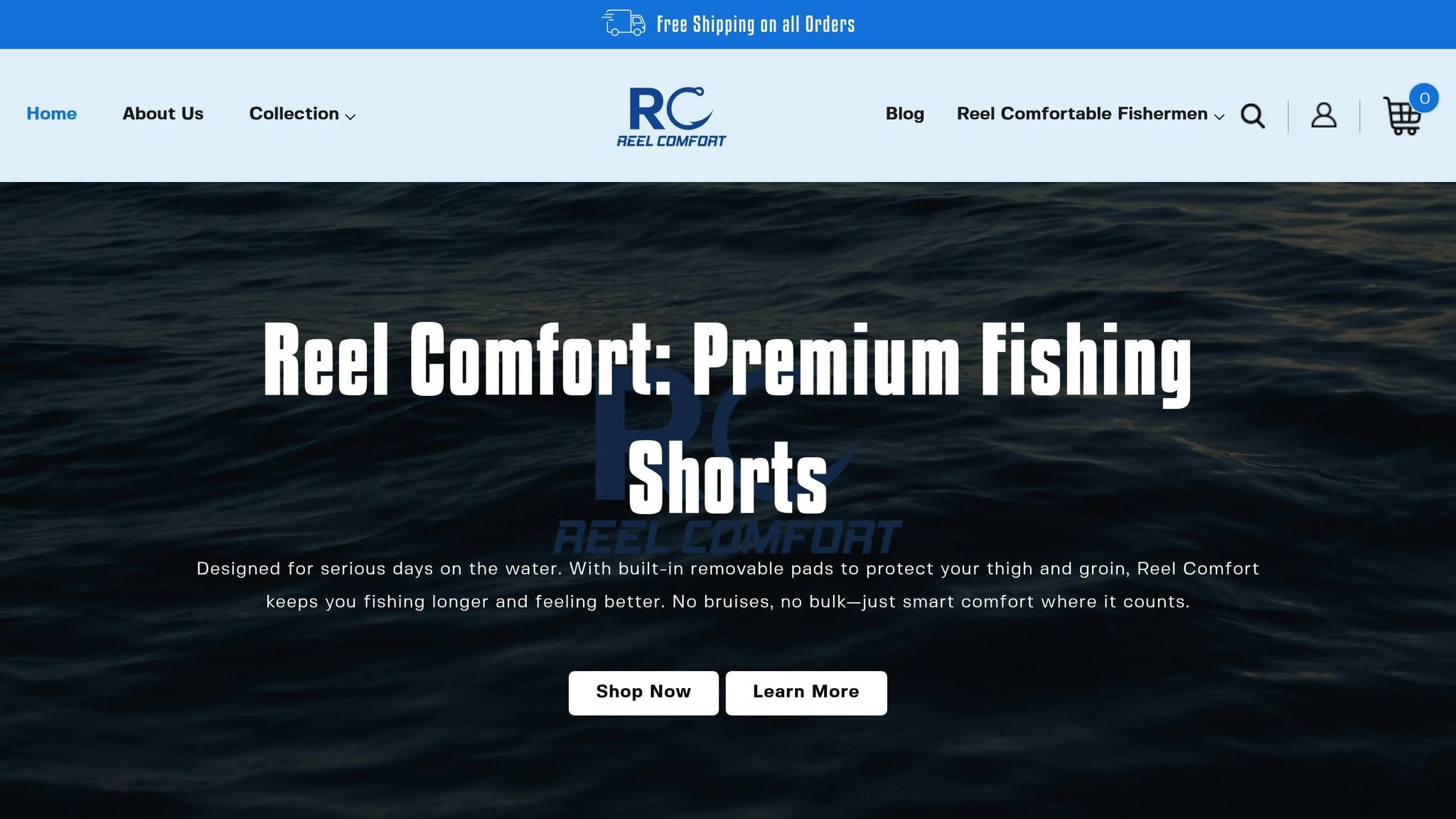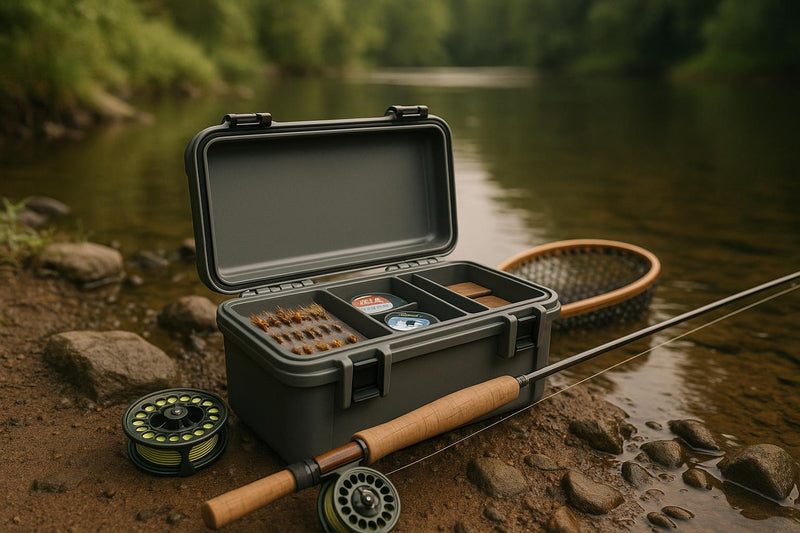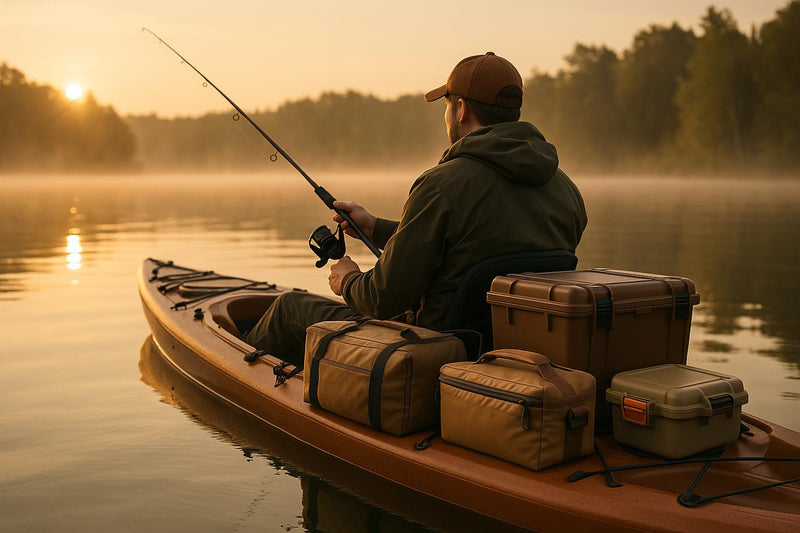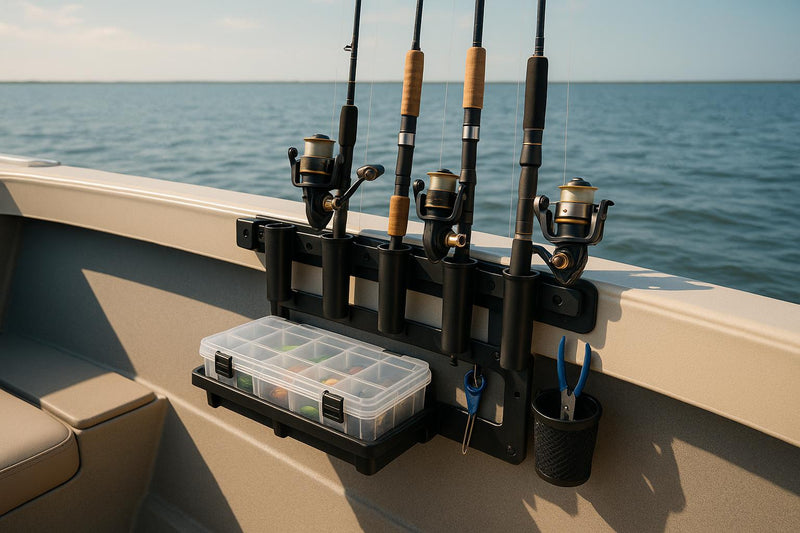Fishing shorts take a beating - constant movement, sun, salt, and gear can wear them out fast. Quality stitching is the key to durability, comfort, and long-term use. Here's what to look for:
- Double Stitching: Found in high-stress areas like inseams and waistbands, it adds extra security.
- Consistent, Tight Stitches: Even spacing and no loose threads signal precise craftsmanship.
- Special Seams: Flatlock and overlock seams lie flat to reduce chafing.
- Reinforced Areas: Stress points like pockets and waistbands should have bar tacks or extra stitching.
- Fabric Compatibility: Stitching should support materials like nylon or polyester for flexibility and strength.
Pro Tip: Turn shorts inside out to inspect seams and check for clean, finished edges. Quality stitching ensures your shorts can handle tough fishing trips without falling apart.
What to Look for in Quality Stitching
When it comes to fishing shorts, quality stitching is what separates gear that lasts a single season from those that accompany you on years of fishing adventures. Paying attention to specific stitching techniques and seam designs can help you spot durable, well-made shorts that are built to last.
Reinforced Stitching Methods
One of the hallmarks of durable fishing shorts is double stitching, a method used in areas that endure the most stress, like inseams, pocket attachments, and waistbands. This technique involves two parallel rows of stitches, adding an extra layer of security. If one row of stitches gives way, the second line ensures the fabric stays intact.
Top manufacturers often pair double stitching with premium materials, such as 3-Ply DuPont™ Supplex® Nylon, to bolster high-wear areas like the seat. This combination of strong materials and reinforced stitching ensures your shorts can handle the rigors of fishing trips without falling apart.
Consistent and Tight Stitching
The consistency and tightness of stitching are other key indicators of quality. Uniform stitching - where each stitch is evenly spaced and sized - reflects precise manufacturing and attention to detail. Tight seams are especially critical, as they hold the fabric firmly without puckering or distorting it.
A quick test to check seam quality is to gently tug on different areas. Well-made seams will stay intact without creating gaps. On the other hand, uneven or loopy stitching signals poor tension control, which could lead to weak points in the garment.
Another detail to look for is the absence of loose threads. Clean finishing work ensures that all threads are securely tucked into the seams, preventing unraveling over time. Additionally, a higher number of stitches per inch (SPI) indicates stronger, more durable seams that can withstand the demands of active use.
Special Seams and Fabric Types
Advanced seam designs like flatlock and overlock seams are often used to enhance both comfort and durability. These techniques overlap the fabric edges and stitch them together so the seams lie flat against the skin, minimizing the risk of chafing during long fishing trips.
Some fishing shorts go a step further by incorporating specialized threads. For example, wooly thread adds softness and stretch, while stretch nylon thread boosts seam durability. These thoughtful additions ensure that seams can handle the movement and flexibility required during active angling.
The type of fabric also plays a huge role in performance. Fishing shorts are often crafted from lightweight, quick-drying materials like nylon or polyester, sometimes blended with spandex for added flexibility. As noted in Reel Comfort's discussion on quick-dry fabric technology, these fabrics are designed to dry fast and provide a full range of motion. The stitching must complement these materials, maintaining their stretch and recovery without compromising durability.
Another feature to look for is coverstitch seams, which are created using double or triple needles. These seams produce clean, flexible hems that move with the fabric, making them ideal for areas like leg openings where both comfort and strength are essential.
How to Check Stitching Quality Before Buying
When it comes to fishing shorts, inspecting the stitching quality can reveal a lot about their durability and craftsmanship. Whether you’re shopping in-store or browsing online, these tips will help you spot garments designed to handle the demands of your fishing adventures.
Check Seams and High-Stress Areas
Start by examining the areas that endure the most wear and tear during fishing trips. The thigh area is particularly important because it often comes into contact with your fishing rod, creating friction. Run your fingers along the side seams to check for any gaps or irregularities.
Next, inspect the pocket attachments, where the pockets meet the main fabric. These areas take a beating from carrying tackle, pliers, and other gear. Look for reinforced stitching techniques like bar tacks or additional rows of stitches around pocket openings - these add extra durability.
Don’t overlook the waistband area, which stretches frequently and supports the weight of items in your pockets. Double stitching along the waistband is a good sign, as is securely attached belt loops.
Turn the Shorts Inside Out
Flip the shorts inside out to get a closer look at the seams. High-quality shorts will have flat, finished seams on both sides. Check for serged or overlocked edges, which are designed to prevent the fabric from unraveling.
Pay attention to whether the seams lie flat without puckering or bunching. Puckering not only looks sloppy but can also weaken the garment over time. Smooth, well-pressed seams contribute to a better fit and ensure the shorts last longer.
Once you’ve inspected the garment in person, compare your findings with the product details provided online or on the tags.
Review Product Details
After your physical inspection, dive into the product details for more clues about quality. If you’re shopping online, look for terms like "bar tacks", which indicate reinforced stitching. For example, AFTCO’s Original Fishing Short® Long highlights "27 bar tacks keep it strong in all the right places".
Other details, like a "double-layered rear for strength", signal added durability in high-wear areas. Materials matter too - features like Dupont Supplex 3-ply nylon show a focus on creating tough, long-lasting shorts.
Customer reviews can also provide insights into how well the shorts hold up over time. For instance, one verified customer, Robert Meredith, shared:
"Have owned AFTCO shorts in the past. These continue the quality--made to withstand what they are put through. Fit perfectly." - Robert Meredith, Verified Customer
Additional features, such as "DWR stain resistance" or specialized designs like Cordura-lined pliers pockets, reflect thoughtful construction and attention to detail.
When comparing options, think about how these features align with your fishing needs. As highlighted in our guide on padded fishing shorts vs regular shorts, specialized construction techniques are essential for ensuring these features remain effective trip after trip.
Why Reel Comfort Fishing Shorts Stand Out

When it comes to fishing shorts that can handle the demands of long days on the water, Reel Comfort's Fishing Shorts deliver with durability and smart design. They feature advanced reinforced stitching, ensuring seams hold up against daily wear and tear during extended fishing trips. Made with rip-stop fabric, a quick-dry finish, and four-way stretch panels, these shorts offer both comfort and mobility for all-day use. Plus, their water-resistant properties make them a dependable choice for wet conditions, combining practicality with thoughtful design.
Reinforced Stitching and Smart Construction
Reel Comfort fishing shorts are built to endure rugged environments and frequent use, thanks to their reinforced stitching. Key stress points are reinforced with specialized construction techniques, boosting the shorts' longevity even further. By blending high-quality materials with meticulous craftsmanship, these shorts are designed to perform reliably in tough conditions.
Removable Thigh Pads and Practical Storage
One standout feature of these shorts is their removable thigh pads, which are securely held in place with precise stitching. These pads fit neatly into hidden thigh pockets, providing a cushioned surface for resting a fishing rod. This thoughtful addition makes tying knots or handling gear much easier. The shorts also include deep, secure hand pockets and slim thigh-pad pockets, all reinforced for extra durability. This combination of technical precision and practical design ensures these shorts are as functional as they are comfortable.
Real anglers have praised these features:
"These shorts let me rest my rod on my thigh without scraping up the handle. It makes a huge difference when tying knots while standing in my kayak. The quality and price are huge perks, too."
- Jason M., Florida Bass Angler
"I love how simple it is. The pads are soft but hold the rod steady - no extra contraptions needed and built to last."
- Carlos R., Tournament Angler
At $59.99, they’re available in black, grey, and blue, giving anglers options to match their style and preferences.
Explore Reel Comfort's Collection
For a closer look at how quality stitching and thoughtful design translate into real-world performance, check out the full collection of Mens Fishing Shorts. Each pair highlights the reinforced construction techniques discussed here, from precision stitching to anti-chafe ergonomic seams and zippered back pockets. To learn more about what makes these shorts stand out, visit our comparison of padded fishing shorts vs regular shorts.
sbb-itb-cb0a783
How to Care for Fishing Shorts to Protect Stitching
Taking care of your fishing shorts is just as important as picking the right pair. A good care routine ensures the stitching stays intact, which is crucial for those long fishing trips. With proper washing, drying, and maintenance, you can prevent thread wear and fabric damage.
Washing Methods
Always start by checking the care label - those instructions are there to protect both the fabric and the stitching. Before washing, make sure to remove any sand, salt, or bait residue.
Use cold water for washing. If the shorts are heavily soiled, pre-soak them in cold water with an enzyme-based stain remover before running them through a gentle wash cycle. Stick to a mild, biodegradable detergent designed for technical fabrics, like the ones used in quick-dry fishing shorts (check out Reel Comfort's quick-dry fabric technology for an example). Avoid harsh detergents, bleach, fabric softeners, or dry cleaning chemicals, as they can weaken the stitching over time. If you’re machine washing, consider running an empty rinse cycle first to clear any leftover detergent from the machine, and use an "Extra Rinse" setting to ensure all soap is rinsed out.
Once washed, drying and storing your shorts properly is the next step to keep them in great shape.
Drying and Storage Guidelines
Air-drying is the safest option - hang your shorts in a well-ventilated area. If you prefer using a dryer, choose a low heat and gentle cycle to avoid shrinking the threads.
Make sure your shorts are completely dry before putting them away. Even slight moisture can lead to mold or odors, which can weaken both the fabric and stitching. Store them in a dry, ventilated spot, and check on them occasionally to avoid permanent creases or stress on the seams. If you’re storing them for a long time, inspect for any damages like loose buttons or zipper issues and fix them beforehand.
Finding and Fixing Loose Threads
After drying, take a moment to inspect your shorts for loose threads, especially in high-stress areas like pocket corners, waistbands, and inseams. If you spot a snag, don’t cut it! Instead, use a sewing needle to pull the thread back inside the fabric.
"The most important thing to remember when dealing with a snag is to not cut it, as this will create a hole in your fabric and make the problem even worse." – Martha Stewart
Keep a small repair kit handy with a needle, matching thread, and small scissors for quick fixes. For areas that see a lot of wear and tear, consider reinforcing the seams with extra stitching before any damage occurs. Taking these small steps can go a long way in keeping your fishing shorts ready for your next adventure.
Conclusion: Choose Quality for Long-Term Use
When it comes to fishing shorts, the stitching isn’t just a detail - it’s the backbone of performance and durability. By opting for shorts with reinforced seams, consistent stitching, and durable thread, you’re investing in gear that can handle the rigors of serious angling.
Here’s something to think about: doubling the life of a garment can slash its environmental impact by 49%. Quality fishing shorts, like the ones available at Fishing Shorts for $59.99, are built to last. With features like rip-stop fabric and reinforced stitching, they save you money in the long run by standing up to years of use.
Take it from Jason M., a Florida Bass Angler, who says:
"These shorts let me rest my rod on my thigh without scraping up the handle. It makes a huge difference when tying knots while standing in my kayak. The quality and price are huge perks, too."
Tournament angler Carlos R. adds:
"I love how simple it is. The pads are soft but hold the rod steady - no extra contraptions needed and built to last."
Durability starts with strong seams, especially in areas that endure the most stress. Check for reinforced stitching at key stress points and a high stitch density to ensure your shorts can handle the demands of long days on the water. These details might seem small, but they make all the difference when you’re out chasing your next big catch.
Investing in well-made Mens Fishing Shorts means you’ll have reliable gear that performs when it matters most - whether you’re reeling in a trophy fish or spending hours under the sun. In the end, quality pays off with comfort, performance, and years of dependable use.
FAQs
What stitching details should I check to ensure fishing shorts are durable?
When assessing the durability of fishing shorts, the stitching is a key detail to examine. Look for double-stitched seams and flat-felled seams, as these are built to withstand stress in areas prone to wear, like the pockets and crotch. Reinforced stitching in these spots adds an extra layer of toughness, helping the shorts endure demanding fishing conditions.
You’ll also want to spot zigzag or stretch stitches. These types of stitching not only boost flexibility but also strengthen the fabric, allowing it to move with you without losing durability. This is especially valuable for anglers who rely on dependable gear during extended fishing adventures.
How do I check the stitching quality in fishing shorts before buying?
To evaluate the stitching quality of fishing shorts before buying, take a close look at the seams. Hold the fabric up to the light to check for any gaps or loose threads - these could signal weak or uneven stitching. Durable shorts often feature reinforced, double-stitched seams that are tightly sewn to handle wear and tear.
Another way to assess durability is by gently pulling along the seams. Sturdy stitching should stay intact under slight tension without stretching or coming apart. Also, pay attention to stitch density - shorts with more stitches per inch usually have stronger seams that can endure the demands of fishing trips. Focusing on these details helps ensure you choose shorts that will last.
Why is reinforced stitching important in fishing shorts, and how does it improve their durability?
Reinforced stitching plays a key role in the durability of fishing shorts, especially in high-stress areas like the pockets, seams, and crotch. These spots take the most strain during activities such as casting, bending, or climbing in and out of boats.
Techniques like double stitching or bartack reinforcement help prevent tearing or unraveling, even with regular use. This extra layer of strength ensures your fishing shorts can withstand the rigors of extended trips, giving you reliable performance every time you’re out on the water.




